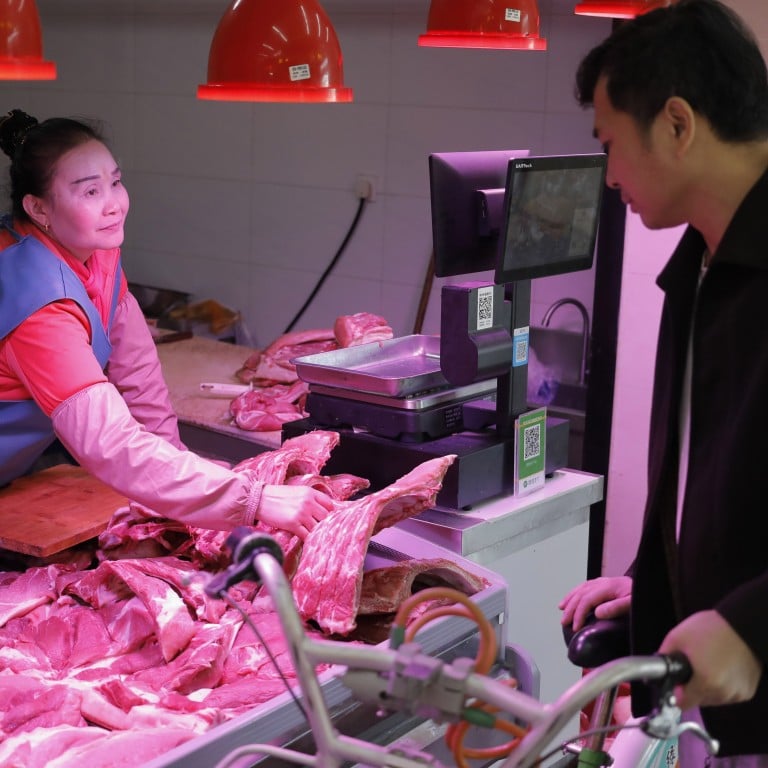
China’s pork price jumps 110 per cent, sending consumer inflation rocketing to eight-year high
- The consumer price index (CPI) rose to 4.5 per cent from a year earlier, up from a 3.8 per cent gain in October
- China’s producer price index, a measure of the prices manufacturers charge at the factory gate, was minus 1.4 per cent year-on-year in November
A 110.2 per cent increase in the price of pork from a year earlier led to a further rise in China’s consumer prices in November, as African swine fever continued to take a toll on the country’s pig population, data released on Tuesday showed.
China’s consumer prices have steadily increased all year having stood at 1.9 per cent in January. The highest CPI reading on record was the 8.2 per cent recorded in March 2008 during the global financial crisis.
The November increase was above the 4.3 per cent increase expected by analysts in a survey by Bloomberg.
China, the world’s largest consumer of pork, has been grappling with a massive shortfall in supply due to the African swine fever crisis , which is predicted to wipe out half of China’s pig population by the end of this year.
With demand shifting to other forms of protein, prices of beef, mutton, chicken, duck and eggs rose by between 11.8 per cent and 25.7 per cent last month from November 2018.
“Food inflation continued to climb on the back of disruptions to pork supply caused by African swine fever – pork price inflation inched up from 108 per cent year-on-year to 110 per cent last month. While non-food inflation, inched up slightly, it remains much below 12-month average. Core inflation [which strips out both food and energy prices] inched down slightly,” said Julian Evans-Pritchard, senior China economist at Capital Economics.
There had been some good news on Monday, with the Ministry of Agriculture and Rural Affairs confirming that China’s pig herd increased by 2 per cent in November compared with the previous month. This was the second consecutive month of a rise in the breeding herd inventory, with sow stocks up 4 per cent on October.
There are signs that pork price inflation may be close to a peak. Pork prices rose only modestly in month-on-month terms last month and China’s pig herd expanded for the first time in a year. Easing food inflation and muted demand-side price pressures should strengthen the case for further monetary easing
“There are signs that pork price inflation may be close to a peak. Pork prices rose only modestly in month-on-month terms last month and China’s pig herd expanded for the first time in a year. Easing food inflation and muted demand-side price pressures should strengthen the case for further monetary easing,” added Evans-Pritchard.
In contrast, the producer price index (PPI), reflecting the prices that factories charge wholesalers for their products, was minus 1.4 per cent year-on-year in November.
That was better than October’s reading of a minus 1.6 per cent and above the 1.5 per cent increase expected by analysts.
There are few signs of a pickup in demand-side price pressures, as core consumer price inflation and producer price inflation remained broadly unchanged
Despite the slight improvement, the negative price data still indicates manufacturers are increasingly having to discount their products due to the slowdown in the economy amid the trade war with the United States.
“There are few signs of a pickup in demand-side price pressures, as core consumer price inflation and producer price inflation remained broadly unchanged,” said Evans-Pritchard.
“The contraction in producer price inflation moderated from minus 1.6 per cent year-on-year to minus 1.4 per cent. But in month-on-month terms, PPI turned negative again, falling 0.1 per cent. Higher prices of consumer goods in the PPI basket, one component of which is food, were more than offset by more pronounced declines in the prices of industrial goods.”

